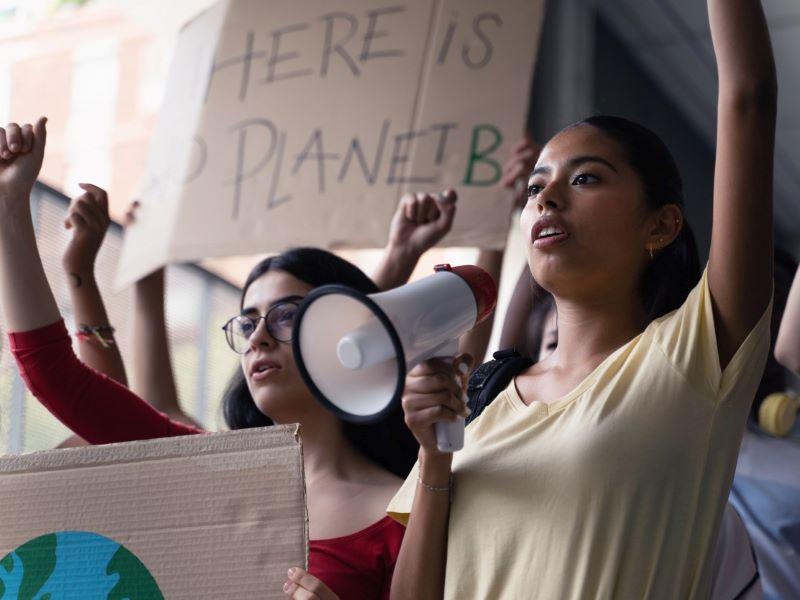
Working with student activists to speed up progress towards a sustainable future

Within higher education, it is the norm for strategic planning, decision-making and action to involve a long, drawn-out process, but what happens when there is an urgency to act? We are learning from the climate emergency that communication is a key route to action, and sometimes the “blah, blah, blah” is necessary.
At the University of Glasgow, the grassroots, student-led Green New Deal (GND) has emerged in recent years to challenge senior managers to act more quickly on ethical and sustainability issues. As the first Scottish institution to declare a climate emergency in 2019, the university is working towards an ambitious target to achieve carbon neutrality by 2030, but the GND in its 79-page manifesto suggests that change is not happening quickly enough.
- Supporting student action on sustainability
- Prepare for student sustainability demands to go through the roof
- Changing lives through community engagement and outreach
Days before COP26 engulfed the city, the students called a meeting with the university principal and asked him to commit to the 60 demands laid out in the manifesto. The demands cover a range of areas, including investment practice, travel and transport, buildings and infrastructure, and curriculum. As director of the Centre for Sustainable Solutions, I was invited to join the meeting.
Ahead of the meeting, a student asked if I was going to stand with “us” or “them”. Having read the manifesto, my answer fell short of picking a side. Instead, I recognised an opportunity to accelerate planned progress and set up strategic thinking around demands that proposed more difficult objectives.
The tone within the manifesto creates a struggle between “us” (the students) and “them” (the senior management), when we all want to achieve the same goals. Rather than resist demands, institutions should work with student activists to act and make change.
How to accelerate grassroots change?
The Centre for Sustainable Solutions itself was created to bridge the gap between what was happening at the grassroots level and more senior levels of the university as a means to accelerate change. The manifesto provided an ideal vehicle to put this into practice. Here are the lessons we have learned along the way.
1. Bridge the gap between the grassroots activists and senior management
Visibility of what is happening across the university is key in bridging the gap. An important first step is to conduct a comprehensive audit of sustainability-related activities happening across the university including research, teaching, operations and outreach.
We took these audit results and began to share them as a repository of monthly spotlights on a single sustainability webpage. This gave us the ability to link related activities across the university and to approach those leading them to offer positive support in making their work visible. The connections feed into our biweekly newsletter and have developed into a network that is more than 200 students- and staff-strong.
2. Create an ongoing dialogue between activists and institutional leaders
Ensure that the hard work and strategies being developed and implemented at senior level are made apparent to all students and staff. There is often a perception among the grassroots that institutions are taking less action to improve sustainability than is in fact the case.
Through audits and communication with staff and students across the university, we were repeatedly told that the university was not doing enough. In reality, the university was creating high-level, ambitious strategies and action plans, but these were not transparent to the wider community.
There was a big divide in communication between the GND students and institutional leaders. The issue with the GND demands is that the university does not operate in such a way that a single person – even the principal – can agree to and push an agenda forward. So over the coming months, the centre will host and facilitate discussions to translate many of the demands into action plans. We need to make sure the right people are in the room to progress relevant topics and to facilitate constructive collaborative discussions.
3. Reframe “demands” into “solutions”
Our first meeting revealed that we could meet most of the demands in a realistic time frame, and four of the 60 were tackled straightaway, working to reframe demands into solutions by creating clear actions.
For example, the first demand is: “Implement democratic practices and forums to maintain a consistent dialogue with staff and students around environmental performance.”
Students wanted to see different participatory approaches such as student assemblies. The dialogue included representation from senior management, professional services and academics and identified that these sessions needed to be extended beyond the student body to create ongoing momentum.
A clear set of actions was created, attributable to participants in the meeting. The actions will see the establishment of a Sustainability Open Forum supported by the Student Representative Council, the University and College Union and the university. The Sustainability Working Group will publish its minutes to make environmental performance and decision-making more transparent and accessible.
4. Establish ongoing regular assemblies for all key stakeholders
Where possible, engage the whole university community in decisions and plans on an ongoing basis so they feel that their voices are heard. After our initial discussions, we created pathways to extend discussions about the demands to the broader university community.
The Sustainability Open Forum will convene biannually, with topics shaped by the 60 student demands. While students have a presence on nearly all committees in the university, their manifesto highlighted a lack of representation on the investment committee. We will renew and facilitate earlier discussions between the student body and the finance committee to ensure that the student voice is heard on matters of investment or disinvestment.
Embedding these channels of communication into our everyday practice is key, so that the students have a clear and visible input into university decisions.
Key lessons from university-student collaboration
At this pace, we could make it through all 60 GND manifesto demands in just 14 hours of meetings, but there are lessons to be learned here.
First, listening to students’ demands and working together to turn them into actionable tasks will take forward the sustainability agenda more swiftly and with greater buy-in.
Second, collaborative insights achieved during our very first meeting helped to tackle the challenge of making visible high-level actions that the university is already taking around environmental sustainability.
Third, the discussions give the students first-hand experience in how the university operates as an institution and demonstrates that decision-making, albeit a long process, is democratic and considers the perspectives of a wide range of representatives.
This is the start of the journey. These intergenerational conversations will hopefully add depth and richness to how we move forward. While the University of Glasgow has always been an open forum for discussions, the challenges of the climate crisis and sustainability require more efficient pathways to transformative change.
Jaime Toney is a professor in environmental and climate science and director of the Centre for Sustainable Solutions at the University of Glasgow.
If you found this interesting and want advice and insight from academics and university staff delivered directly to your inbox each week, sign up for the THE Campus newsletter.


